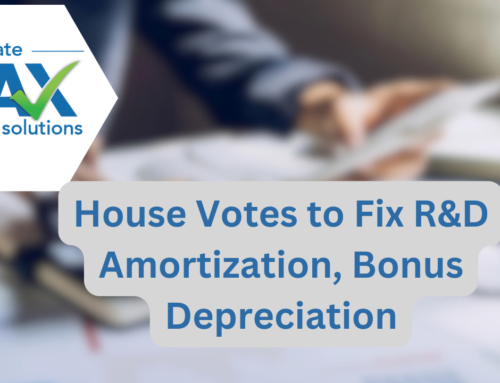The latest on new R&D expense rules
Key Takeaways
- R&D expenses now must be amortized over 5 years (15 years for foreign expenses)
- This is a change to R&D deductions not R&D credits
- Amortization is consider by many to be horrible tax policy that will most likely be repealed by Congress
- Until its repeal, companies will only be able to deduct 10% of total section 174 costs in 2022
- Companies that continue to spend on R&D will recover all tax costs by years 5 or 6
- Section 174 R&D expenses go beyond what is allowed for Section 41 R&D Credits
- IRS will allow for a one-year automatic change in accounting to “ensure swift compliance”
- Companies that seek to dodge amortization will be on the IRS radar
- Repeal has bi-partisan support but remains a political football
Background: How we got here
American business owners and their tax advisors are becoming increasingly aware of the pain that may be inflicted by a little-known provision in the Tax Cuts and Jobs Act (TCJA). This portion of the law eliminates the ability to deduct R&D expenses in the year incurred, and now requires businesses to amortize these costs over 5 years beginning in 2022. This is a profoundly anti-business measure and, if it remains, millions of American businesses will experience a substantial tax hike as a reward for investing in R&D. The US will also become the second worst country in the developed world for R&D incentives.
This provision was buried within the TCJA as a way to show that the law raises revenue to an extent that it would not have had to go through the reconciliation process. This is an often-used trick; however, it was always assumed that Congress would repeal such a harmful provision before it was ever able to see the light of day. In 2021 and 2022, there were numerous bills from both parties put forth to repeal R&D amortization. Yet they were never able to come to an agreement on repeal (more on that later). Now that 2022 tax season is in full-swing, business owners are becomingly shockingly aware of how much this law will impact cash flow.
How this affects businesses
First things first, we are talking about a change to Code Section 174, which used to allow for immediate deduction or amortization of R&D expenses. The new law states that specified R&D expenses (including all software development costs) must be deducted over five years, beginning in 2022 with a mid-year convention. This means that if a company has $1,000,000 in R&D expenses (an easy assumption for many mid-size businesses) they will be able to deduct $100,000 in year 1, 200,000 in year 2, and so on until the costs are recovered in year 6.
This essentially creates a timing issue since the costs will eventually be recovered, but not without the short term pain of a massive tax increase. At a 35% tax rate, losing the ability to deduct $1 million would result in an additional $315k of taxes owed by the business in Y1. As long as the company continues to invest in R&D, the impact would diminish each year as new amortized costs are picked up. This change is only for tax purposes and will not affect how companies keep their books.
R&D Credits not changed
Many sources reporting on this issue have been confusing R&D Credits with R&D deductions. The R&D Credit has not changed, and companies can still utilize 100% of their R&D credit. However, there is interplay between section 41 credits and section 174 deductions. Any company that has claimed an R&D Credit on past tax returns will be subject to the new R&D treatment. Unfortunately, Section 174 R&D costs go beyond what is allowed under the R&D credit. While the R&D Credit takes into account wages, contractors, supplies, and cloud lease costs, Section 174 includes all of these plus others:
- Patent attorney fees
- Labor plus OH burden
- Rent and utilities for R&D space
As of now (Feb 20th, 2023) the industry is still waiting on the IRS to issue guidance on what constitutes a 174 R&D cost. The ambiguity on this issue has led many tax advisors to consider filing extensions for anyone impacted by the new law.
IRS Issues Change of Accounting Procedures
The IRS has released procedures dictating how companies are to adopt the change in accounting on their tax returns (Rev. Proc 2023-8). This procedure allows for a one-year ability to automatically change methods by making a declaration on an original 2022 return.. Anyone seeking to comply with the new rules in later years will be forced to jump through more hoops to claim R&D expenses.
What is Congress up to?
All legislative history indicates that Congress does not intend to penalize R&D activities. Yet, here we are in the middle of tax season and business owners are now looking at how they are going to come up with the cash to pay taxes on phantom income that does not actually exist. For some companies, the change is a drop in the bucket of overall deductions. Others now owe more money in taxes than they had in actual profit! I would expect more business owners to begin knocking on their congressperson’s door as they fight a tax change that may put them out of business.
There is some insider baseball on Capitol Hill behind all of this. As mentioned, both parties wish to repeal the requirement (and even expand R&D incentives). However, ATS has found that there are two main obstacles:
- Many Democrats will not agree to restoring R&D expensing until the Child Tax Credit is made permanent (many Republicans support the CTC but oppose Democrat’s wishes to make it available for non-working individuals)
- Some Democrats seek to punish big corporations for stock buybacks and other supposed equity issues by withholding R&D expensing
Both sides are in fact to blame for this debacle. Republicans passed the TCJA with this irresponsible clause, and while Democrats may think they are fighting big corporations, in reality, small business will, of course, bear the brunt of the cost.
What happens next?
In the end, everyone comes out a loser if this law stays in place. Businesses will need to scrap plans to expand and operate in order to pay taxes on phantom income, while the US will certainly suffer from a lack of R&D investment and access to important new technologies. ATS expects that this issue will be taken up before the looming debt ceiling battle and that it will be repealed. While it’s true our political system is very broken right now, failing to fix this tax law is in nobody’s best interest. However, while we hope for best, it is tax season, so we must plan for the worst.
Contact ATS for a Free Consultation on R&D Tax Planning.





